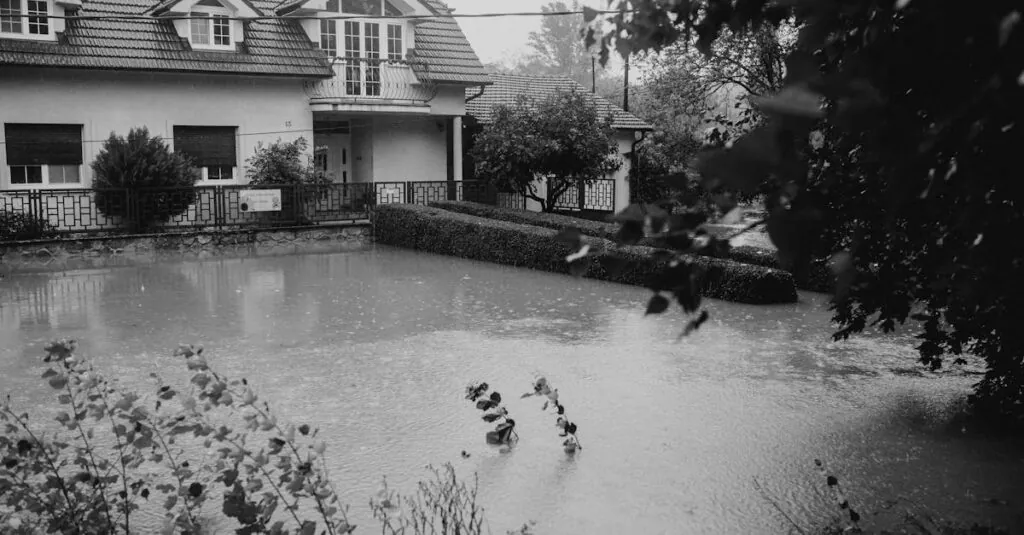Table of Contents
TogglePicture this: a storm rolls in, winds howl like a banshee, and suddenly, that majestic oak in your yard becomes a projectile. You’re left wondering if your home insurance will swoop in like a superhero to save the day. But does it really cover tree damage?
Overview of Home Insurance
Home insurance provides financial protection against various disasters. Policies typically cover damage to the home and personal belongings due to events like fire, theft, and certain natural disasters. Each policy varies, and understanding the nuances is crucial for homeowners.
Coverage usually includes dwelling protection, which covers the structure of the home itself, along with personal property coverage for belongings inside. Liability coverage protects homeowners against claims for injuries or damages sustained by others on their property.
Homeowners should also consider additional living expenses coverage. This type of coverage helps pay for temporary housing if the home becomes uninhabitable after an insured incident.
Tree damage coverage often depends on specific circumstances. Policies may cover removal of fallen trees if they damage the home or other covered structures. If a tree falls due to a storm, damage may be covered. However, if a tree falls due to neglect or lack of maintenance, homeowners often bear the repair costs.
Consulting the policy details is essential to confirm what is and isn’t covered. Homeowners can also speak with their insurance agent for clarification on tree-related incidents. Understanding these specifics ensures they’re informed about their coverage before an incident occurs.
Understanding Tree Damage Coverage
Home insurance coverage varies significantly when it comes to tree damage. Policies often cover specific scenarios where a tree causes harm to the home or other insured structures.
Types of Tree Damage Covered
Fallen trees that damage the dwelling, garage, or shed typically qualify for coverage. Removal costs may also be covered if the tree lands on these structures. Damaged fences or other insured property might receive financial support as well. Coverage usually depends on the cause of the damage, with storm-related incidents generally included.
Situations Where Coverage Applies
Circumstances impacting coverage often hinge on the event’s nature. Policies usually extend protection if a tree falls during a storm, as this falls under a common peril. When negligence leads to a tree’s collapse, insurance might deny claims. To confirm coverage, homeowners should scrutinize policy details and consult an insurance agent. Understanding these situations aids homeowners in recognizing when to expect support from their insurance.
Factors Affecting Coverage
Several factors influence whether home insurance covers tree damage. Understanding these elements helps homeowners navigate their policies effectively.
Policy Limits and Deductibles
Policy limits determine the maximum amount an insurer pays for tree damage. Each policy has a specific coverage cap which may vary significantly. Homeowners should check the limit for property damage. Deductibles play a crucial role in coverage, as homeowners must pay a certain amount before insurance coverage kicks in. Higher deductibles often reduce premiums but may result in increased out-of-pocket expenses during a claim. Homeowners may find themselves more financially impacted if the damage exceeds their policy limits or deductibles.
Specific Exclusions
Certain exclusions might affect coverage for tree damage. Policies often exclude damage from neglect or lack of maintenance on the homeowner’s part. If a tree falls because it was diseased or weakened without prior intervention, the insurer may deny the claim. Policies might also overlook damage from trees uprooted during natural disasters. Some insurers exclude specific natural events or circumstances that lead to damage, impacting overall coverage. Homeowners should carefully review their policy for any such exclusions.
Steps to Take After Tree Damage
After tree damage occurs, homeowners should immediately assess the situation. It’s essential to prioritize safety before anything else. If the tree still poses a threat, maintaining a safe distance is crucial.
Documenting the Damage
Start by taking clear photographs of the damaged tree and any affected structures. Record detailed notes about the incident’s timing and circumstances, including the type of storm that occurred. Documentation should include various angles and distances to provide a comprehensive view. This evidence lays the groundwork when reviewing policy coverage. Including specific details like the extent of damage supports the claim process. Homeowners may also want to note any previous maintenance performed on the tree to show responsible ownership.
Filing a Claim
Contact the insurance provider as soon as possible to initiate the claims process. Providing detailed documentation collected earlier will expedite the review. An agent may require specific information about the incident and the type of damage sustained. Be prepared to discuss the tree’s condition before the incident occurred. Understand policy limits and deductibles to set realistic expectations. Expect to fill out necessary forms and submit documentation promptly. This approach helps move the claim toward resolution efficiently.
Homeowners facing tree damage should know that coverage often hinges on specific circumstances. While many policies provide protection for trees that cause damage during storms, neglect can lead to denied claims. Understanding the nuances of one’s insurance policy is crucial.
Homeowners are encouraged to review their coverage details with their insurance agent to ensure they’re prepared for potential incidents. By being proactive and informed, they can navigate the complexities of tree damage claims more effectively, minimizing stress during challenging times.







